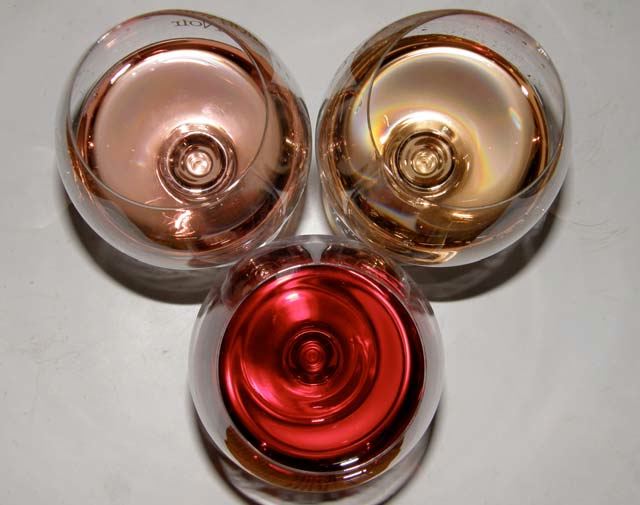No Need to Blush When Drinking Rosé
Pinot Noir Rosé is a favorite of mine, particularly as the weather warms in the dog days of summer. No need to
blush or feel embarrassed to admit you like dry Rosé for it is one of the world’s most versatile food
companions. Dry Rosé has become de rigueur in restaurants in Paris (often as Pinot Noir versions from
Sancerre or Grenache from southern France), Spain (where it is often made from Tempranillo and called
rosado), Italy (often crafted from Sangiovese and called rosato), and picnic tables here in the United States.
(from red grapes that a winery specializes in, but often Pinot Noir). There are many devotees, a number of
which are members of Rosé Avengers and Producers (RAP), founded in 2005 to preach against wine racism
and right the wrongs done to dry Rosé (www.rapwine.com). The organization holds Pink Out! gatherings to
celebrate fine Rosé.

Pink-hued wines made from Pinot Noir go by many names including Rosé, blush, and vin gris, with the term
‘blush wine‘ coming into popularity in the 1970s. Rosé is the French word for pink. Vin gris (van GREE) is
French for gray wine. The French refer to dark-skinned grapes as black or noir and grapes that are
somewhere in between black and white as gris. There are no pink grapes (grapes with pink skins) per se, but
red-skinned grapes can produce wine that is dark red, pink or white. Rosé can be made from any red grape,
but Pinot Noir Rosé from California and Oregon is very popular.
Rosé wines are not new, having introduced many neophytes to wine over the last fifty years. Slightly sweet
Mateus and Lancers Rosés were a favored quaff of young people of my baby boomer generation. Jay
McInerney (Bacchus & Me 2002) remarked: “Back in the summer of 1973 I probably derived just as much
pleasure from that first bottle of Mateus as I have from any number of first-growth clarets since. Maybe more.
I had just acquired my driver’s license, I was in the company of my first love; the night and, beyond it, the entire
summer stretched out ahead of me like a river full of fat, silvery pink-fleshed fish. And that was what the wine
tasted like. It tasted like summer.” More recently white Zinfandel, which is the third best-selling varietal wine in
California, has filled the role. These slightly sweet rosés appeal to the American soda pop palate, but often
lead to interest in serious, bone-dry versions which have become increasingly popular.
Rosé is intended to be drunk immediately while it is fresh, although serious examples may improve in the bottle
for a year or two. There are three methods of production. The first, adding red wine to white wine, has fallen
out of vogue and is mainly reserved for sparkling rosés. The second approach involves lightly crushing the
grapes, chilling them, and cold macerating them for up to 48 hours. The juice is then drained off and fermented
in stainless steel in a manner similar to the production of white wine. The third method, saignée, eliminates the
cold soak. Whole or crushed grapes go into a fermentation vat, the color is periodically checked, and the free
run juice is drained or bled off to finish fermentation in a separate tank. In the last two methods, fermentation is
completed without further skin contact, leaving the most of the color, flavor compounds and tannins in the skin
behind. The juice is typically bottled shortly after fermentation with no oak barrel aging.
Pinot Noir Rosé is best served slightly chllled at 55ºF (warmer than refrigerator temperature of around 35ºF).
No contemplation is needed, for these wines are to be enjoyed for their refreshing charm. Many examples are
bottled in screw cap. Unfinished bottles can be closed and kept in the cellar or refrigerator for a few days
without significant loss of flavor.
Unfortunately, wineries do not produce Pinot Noir Rosé in significant quantities, despite its popularity. Pinot
Noir grapes are expensive, vinification can be costly when a serious Rosé is crafted, and yet the wines
demand only a half or a third of the price of a premium Pinot Noir. The wines reviewed below, ranged in price
from to $15 to $30. The wines are typically released in the spring of the year following harvest and disappear
rapidly from the marketplace.
The packaging of Rosé is often quite alluring. Unusual bottle shapes and colorful labels are frequent. Names
can be creative (“Pink Belly,” “Kinky Pink,” “Endless Crush,” “Pink Fiddle”). Colors can range from a faint
apricot to a deep strawberry red, reflecting the length of contact between the wine and the skins (In photo
below from upper left clockwise: Ellipsis, Ott, and Calera). The aromas are often shy and not particularly
complex. Unlike Pinot Noir, where much of the enjoyment comes from smelling the wine, the pleasure of rosé
comes from the bright flavors more than the perfume. Tannins are minimal, making the wines a perfect
accompaniment to summer fare including hot dogs, sausages, hamburgers, grilled chicken and seafood,
chicken salad, crab or shrimp Louis, and my favorite, a BLT sandwich.

Two Rosés that stood out are reviewed elsewhere in this issue: 2010 Inman Family Endless Crush Russian
River Valley Pinot Noir Rosé and 2010 La Rochelle Santa Lucia Highlands Pinot Noir Rosé. I added a
French Rosé to this tasting for comparison.
2010 Cartha Sonoma Coast Pinot Noir Rosé
12.9% alc., $15.
·
Light pink
coral color in the glass. Shy nose offering demure aromas of blueberries, pear
and wet rock. Restrained and soft in the mouth with subtle flavors of red berries,
peaches and herbs with a lively kick of acidity in the background. A pleasant,
but simple wine. Good.

2010 Ellipsis Wine Company Russian River Valley Rosé of Pinot Noir
13.4% alc., $15, screw cap.
·
Pale pink with a very
slight spritz upon pouring. Lovely array of fresh scents including
strawberries, watermelon, rose petals, wild flowers and nuts.
Crisp, bright and dry with flavors of red berries and blood
oranges and a slight grassy, herbal note in the background. An
edgy wine that is everything a Rosé should be. Source: website (e-mail inquiry)
and retail (Raley’s Markets, Sonoma County).
2010 Calera 35th Anniversary Central Coast Vin Gris of Pinot Noir
14.5% alc., $16. 60% San Ysidro
Vineyard (Santa Clara County) and 40% Doctor’s Vineyard (Monterey County).
·
Deep strawberry color in the
glass. Scent of red berries and red plums. Drinks more like a lighter-weighted Pinot Noir than a Rosé with
fairly hearty flavors of red berries, cherries and subtle herbal oak, finishing with on a dry, crisp note. Source:
website and retail. Decent.
2010 Etude Estate Grown Carneros Rosé
13.8% alc., $16.
·
Pale pinkish-orange color in the glass. Very shy
nose with faint aromas of red berries, citrus and new hay. Light and shallow with a core of red berry and
orange peel flavor and a welcoming tang on the finish. Source: winery and retail. Decent.
2010 Lynmar Estate Russian River Valley Rosé of Pinot Noir
14.3% alc., pH 3.42, TA 0.67, 340 cases,
$25, screw cap.
·
Light red rose color in the glass. Shy but pleasing aromas of red berries, cherries and summer
herbs. Moderately intense and creamy for a Rosé with bright flavors of raspberries and strawberries that linger
on the finish. A polished wine of great interest. Source: website and winery. Very good.
2010 Robert Sinskey Vineyards Los Carneros Vin Gris of Pinot Noir
13.9% alc., $26. Tall Riesling style bottle.
·
Medium salmon color in the
glass. Very aromatic with scents of orange zest, melon, strawberry and
summer bouquet. Moderate in weight with appealing flavors of blood
oranges, cherries and red berries. A crisp and clean wine that will work
beautifully on the summer table. One of California’s best producers of
Rosé. Source: website and limited retail.
2009 Emtu Labyrinth Vineyard Sonoma County Rosé of Merlot
12.4% alc.. All profits support
humanitarian projects. Last Rosé as Merlot vines have been grafted over to Chardonnay.
·
Pale burnished
orange color in the glass. Slight spritz initially. Scent of red plum, ripe berries and marzipan. Smooth and light
with mature flavors echoing the nose with an added underpinning of brioche. Lacks a bit of liveliness on the
finish. Source: winery. Decent (+).
2009 MacPhail Sonoma Coast Rosé of Pinot Noir
14.5% alc., $17.
·
Light reddish-orange color in the glass.
Aromas of oak, herbs and barnyard. Fairly intense flavors of alpine strawberries with hints of licorice and
savory herbs, and a prominent tug of oak. Lacks finesse, freshness and brightness. Source: winery and retail.
Decent.

2009 Domaines Ott Côtes de Provence Chateau De Selle Rosé
13.5% alc., $21. Imported by
Maisons Marques & Domaines Oakland, CA.
·
Cool bottle shape. Very light orange color - more orange
than California versions. Aromas of slate, cut flowers and almond paste. Restrained flavors of oranges,
apricots, nutmeg, nuts and caramel. A very classy wine that shows less emphasis on fruit than
California versions of Rosé. Very smooth and dry on the palate. I really liked this wine and saved it for
later drinking.